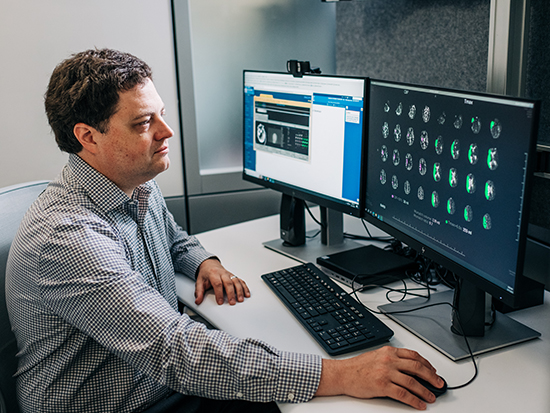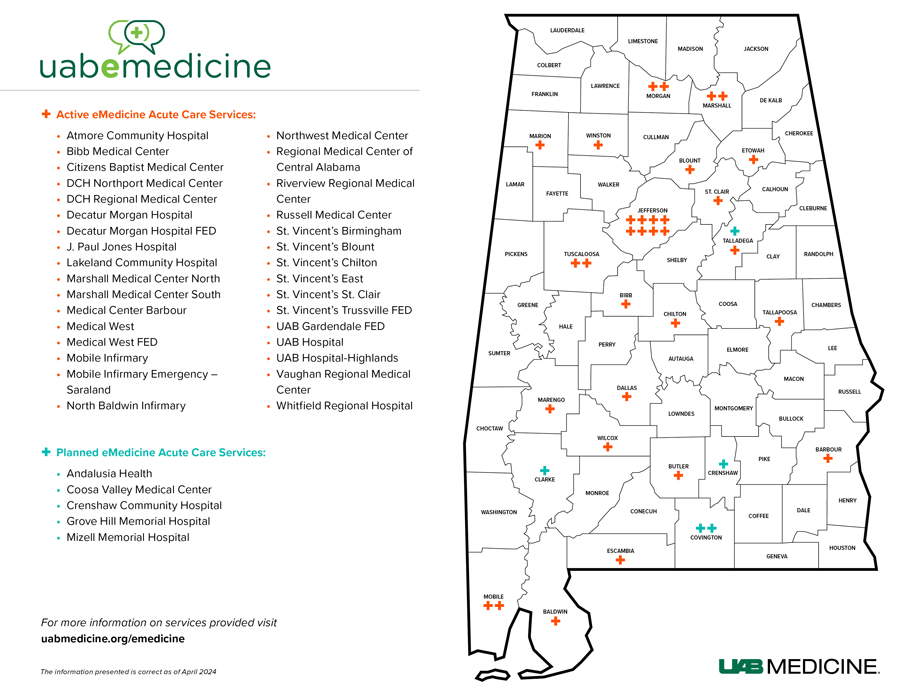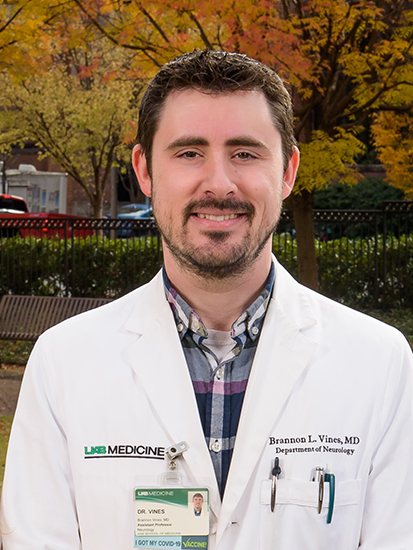 Ekaterina Bakradze, M.D., an associate professor in the UAB Department of Neurology, demonstrates the tele-stroke consult services in the emergency department at UAB Hospital-Highlands, one of 29 locations statewide served by UAB stroke experts.Photo by ANDREA MABRY | Creative and MarketingWhen a patient arrives in an ambulance at the closest emergency room with a suspected stroke, the clock is running. If this patient is having one of the roughly 700,000 ischemic strokes that take place in the United States each year, there is a limited window of only a few hours in which they can receive effective treatments such as the clot-busting drug tPA. But before that, doctors must decide whether this is an ischemic stroke, caused by a clot (about 87 percent of strokes are ischemic), or a hemorrhagic stroke, caused by burst blood vessels, which need a different kind of treatment altogether.
Ekaterina Bakradze, M.D., an associate professor in the UAB Department of Neurology, demonstrates the tele-stroke consult services in the emergency department at UAB Hospital-Highlands, one of 29 locations statewide served by UAB stroke experts.Photo by ANDREA MABRY | Creative and MarketingWhen a patient arrives in an ambulance at the closest emergency room with a suspected stroke, the clock is running. If this patient is having one of the roughly 700,000 ischemic strokes that take place in the United States each year, there is a limited window of only a few hours in which they can receive effective treatments such as the clot-busting drug tPA. But before that, doctors must decide whether this is an ischemic stroke, caused by a clot (about 87 percent of strokes are ischemic), or a hemorrhagic stroke, caused by burst blood vessels, which need a different kind of treatment altogether.
Or it may not be a stroke at all. Some of the same symptoms, including blurred vision, facial drooping and slurred speech, can be caused by conditions mimicking stroke, such as seizures or Bell’s palsy. If it turns out the patient is having an ischemic stroke — something that neurologists decide based on patient evaluation, CT scans and lab tests — other treatments may be warranted. Up to 24 hours after a stroke, specialists can use a “clot retriever” device in a procedure called mechanical thrombectomy that can significantly reduce the chances of long-term disability. But mechanical thrombectomies are available only at a fairly small number of hospitals statewide, including UAB, which is the state’s first hospital to be named a Comprehensive Stroke Center, the highest level of care available anywhere. In fact, UAB has one of the largest neurosciences intensive care units in the United States, along with a dedicated stroke unit.
Today, 29 hospitals and free-standing emergency rooms across the state, a majority of which are in rural areas, have an immediate link to a UAB stroke expert, and the program has provided nearly 7,000 consults for patients.
UAB telehealth brings expert care to rural Alabamians
 When a patient arrives at a remote location, stroke experts such as Michael Lyerly, M.D., medical director for the UAB tele-stroke program (above) can join the on-site team within minutes to consult, interacting with doctors, patients and their families by video.Photo by ANDREA MABRY | Creative and MarketingThe doctors who are best equipped to decide on the proper treatment for a possible stroke case are neurologists. But patients in rural areas across the country with stroke were “significantly less likely” to be seen by a neurologist during their hospital stay than those in urban areas, according to a study published in April 2024 by researchers including UAB epidemiologist Virginia Howard, Ph.D., and biostatistician George Howard, DrPH. That research, part of the massive REGARDS stroke study, examined 839 strokes nationwide from 2003 to 2016. An accompanying editorial noted that “where people live significantly affects the quality of stroke care that they receive.”
When a patient arrives at a remote location, stroke experts such as Michael Lyerly, M.D., medical director for the UAB tele-stroke program (above) can join the on-site team within minutes to consult, interacting with doctors, patients and their families by video.Photo by ANDREA MABRY | Creative and MarketingThe doctors who are best equipped to decide on the proper treatment for a possible stroke case are neurologists. But patients in rural areas across the country with stroke were “significantly less likely” to be seen by a neurologist during their hospital stay than those in urban areas, according to a study published in April 2024 by researchers including UAB epidemiologist Virginia Howard, Ph.D., and biostatistician George Howard, DrPH. That research, part of the massive REGARDS stroke study, examined 839 strokes nationwide from 2003 to 2016. An accompanying editorial noted that “where people live significantly affects the quality of stroke care that they receive.”
For an increasing number of Alabamians, however, that is changing. In 2018, UAB Medicine launched its tele-stroke program at Whitfield Regional Hospital in Demopolis. Today, 29 hospitals and free-standing emergency rooms across the state, a majority of which are in rural areas, now have an immediate link to a UAB stroke expert, and the program has provided nearly 7,000 consults for patients.
When a patient arrives at one of these locations with a suspected stroke, a UAB stroke expert, such as tele-stroke medical director Michael Lyerly, M.D., can join the on-site team within minutes to consult, interacting with doctors, patients and their families by video.
“In Alabama, we are 100 neurologists short of where we need to be,” Lyerly said. “This has really spurred us to expand tele-neurology to hospitals around the state."
Neurologists in short supply statewide
The lack of qualified neurologists in Alabama hospitals has been a known problem for a while and is a contributing factor in Alabamians’ having some of the worst post-stroke outcomes of any state. (The health demographics of residents is another factor, which is a primary focus of the UAB-led REGARDS study.) The problem finding neurologists, if anything, has gotten worse in recent years as the post-COVID financial challenges facing many Alabama hospitals have made it harder for them to justify keeping specialists on staff. “In Alabama, we are 100 neurologists short of where we need to be,” Lyerly said. “We have added neurologists in recent years, but added them in many cases where they already existed.” (In fact, approximately half of the neurologists in Alabama are in the Greater Birmingham area.) “This has really spurred us to expand tele-neurology to hospitals around the state,” Lyerly said.
For some of those patients, the consult with Lyerly or another UAB tele-stroke neurologist will result in a decision to administer tPA, with Lyerly assisting the nurses on-site in constituting the drug for delivery. “tPA can be given up to 4.5 hours after a stroke, and patients who have received tPA might need thrombectomy, which can be done in up to 24 hours,” Lyerly said. But in many cases, the telemedicine consult will result in a diagnosis of something else. “If a patient arrives with isolated facial weakness, the two most common considerations are stroke, which is actually the less common reason, or Bell’s palsy,” Lyerly said. “If it’s a stroke, that means admission to the hospital and likely a transfer. If it is Bell’s palsy, they are started on medication and discharged.”
In addition to saving the patient the time and expense of a transfer to a distant hospital, that correct diagnosis means an ambulance and crew will not be taken out of service for an unnecessary transport, and a larger hospital, more likely to be already full of patients, will have one less patient, reducing wait times for everyone else.
Story continues after map

Neurology care expands for seizures, migraines and more
 Epileptologist Brannon Vines, M.D., director of Neurology Consultation Services for UAB eMedicine, is one of the expert providers available for remote EEG services. "Seizures are going undiagnosed because the majority of hospitals in Alabama don’t have access to specialists to interpret the EEG," Vines said.The success of UAB’s tele-stroke program has led to an expanded scope for other neurology care. In 2020, UAB’s telemedicine program added general neurology consults for emergency and routine care of seizures, migraines that mimic stroke, flare-ups of multiple sclerosis, and other conditions. There also is a remote EEG service, in which an expert neurologist, such as Brannon Vines, M.D., director of Neurology Consultation Services and associate professor in the Department of Neurology, will read and interpret an EEG carried out by a hospital’s on-site technicians. “Many seizures are going undiagnosed because the majority of hospitals in Alabama don’t have access to specialists to interpret the EEG,” Vines said. “As an epileptologist, I see that as a huge problem. We might be able to keep those patients at that site appropriately instead of having them transported to a hospital with a higher level of care.” Without the additional information from the EEG, a patient having a seizure, known as status epilepticus, will be transported away from their community because “if they don’t return fully to their mental baseline, you don’t know if they have fully stopped having their seizure or only partially stopped,” Vines said.
Epileptologist Brannon Vines, M.D., director of Neurology Consultation Services for UAB eMedicine, is one of the expert providers available for remote EEG services. "Seizures are going undiagnosed because the majority of hospitals in Alabama don’t have access to specialists to interpret the EEG," Vines said.The success of UAB’s tele-stroke program has led to an expanded scope for other neurology care. In 2020, UAB’s telemedicine program added general neurology consults for emergency and routine care of seizures, migraines that mimic stroke, flare-ups of multiple sclerosis, and other conditions. There also is a remote EEG service, in which an expert neurologist, such as Brannon Vines, M.D., director of Neurology Consultation Services and associate professor in the Department of Neurology, will read and interpret an EEG carried out by a hospital’s on-site technicians. “Many seizures are going undiagnosed because the majority of hospitals in Alabama don’t have access to specialists to interpret the EEG,” Vines said. “As an epileptologist, I see that as a huge problem. We might be able to keep those patients at that site appropriately instead of having them transported to a hospital with a higher level of care.” Without the additional information from the EEG, a patient having a seizure, known as status epilepticus, will be transported away from their community because “if they don’t return fully to their mental baseline, you don’t know if they have fully stopped having their seizure or only partially stopped,” Vines said.
Physicians at a hospital can order a remote EEG when “a patient has a known history of epilepsy and they are acting a little weird but have no overt, obvious sign of a seizure,” Vines said. “They can even order that before they order the consult.”
General neurology has provided nearly 1,000 consults, Vines says. “We frequently see new diagnoses of epilepsy or provoked seizures that have never been known before and that would not have happened without these remote EEGs,” he said.
Whether it is acute stroke care or routine neurological consults before a surgery, “telemedicine is uniquely suited to this work,” Lyerly said. But the connections between UAB and partner sites are not entirely virtual. “We also provide stroke care training to nurses and physicians at our partner sites,” Lyerly said. “Our goal is to be a member of the patient’s care team, providing them the highest quality of care possible.”
For more information, email